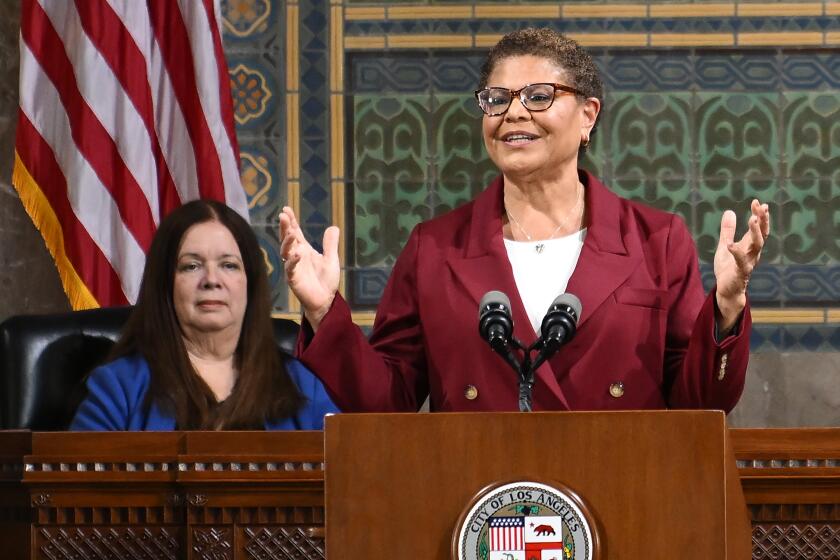Council, Builders Take 2 Tacks to Ease Growth Problems : Housing Projects Put on Hold in Burgeoning Rancho Bernardo
- Share via
Concerned that public facilities in Rancho Bernardo and Rancho Penasquitos are overburdened, the San Diego City Council on Monday temporarily blocked two major residential developments and took other steps to alleviate overcrowding.
While the council members went to great lengths to avoid describing their actions as a moratorium, their votes Monday--at least in regard to Rancho Bernardo--created a legislative roadblock that will effectively halt development there until probably summer.
“Call it what you will, it is, in fact, a de facto moratorium on any new (projects) in Rancho Bernardo,” said Paul Robinson, the attorney for one of the housing projects affected by the council’s action. “They can say that they didn’t declare a moratorium, but the fact is that these projects cannot be finalized because of what they did.”
By a 7-2 margin, the council voted to postpone any further building in Rancho Bernardo, the 24,000-resident community north of Rancho Penasquitos along Interstate 15, until the area’s 8-year-old community plan is updated. City planning officials told the council that the community plan update, now under way, probably will not completed before June.
Worried that planned residential developments would exacerbate already serious traffic congestion in and near their community, Rancho Bernardo residents told the council that allowing new projects to proceed before completion of the community plan amendment would, as one of them put it, “make a mockery of the planning process.”
The Rancho Bernardo leaders, who also generally tried to steer clear of the emotionally charged word “moratorium” in their public comments, argued that a “temporary delay” in construction was needed because, by their count, the number of approved but not yet built subdivisions exceeds the maximum of 16,700 residential units specified in the community plan, which essentially serves as a blueprint for growth. The community residents said that number now is about 17,100. Planning Department figures, including the two proposed projects, are even higher--17,388.
However, Robinson, representing the developer of a proposed 1,003-unit project called Westwood Valley, emphasized that even though the number of approved homes in Rancho Bernardo surpasses the community plan’s maximum, Rancho Bernardo currently has far fewer residents than the 40,000 projected under the plan.
Similarly, Paul Zimmer, president of Avco Community Developers, which plans to build the 940-unit Battle Mountain project, acknowledged that traffic congestion is “discomforting” to Rancho Bernardo residents. He added, however, that all existing and planned public facilities meet city standards.
Councilwoman Abbe Wolfsheimer, whose district includes Rancho Bernardo and Rancho Penasquitos, said that the projects should be held up to ensure that growth does not begin to seriously outpace the capacity of roads and other public facilities.
“This is not a moratorium,” Wolfsheimer said. “It is a condition placed on tentative (development) maps at the Subdivision Board and Planning Commission level” that will delay the two projects until the community plan is updated. Council members Bill Cleator and Judy McCarty opposed the delay.
Semantics aside, both Robinson and Zimmer said that the council’s action would act as a moratorium and delay their respective projects by perhaps several months each.
Residents of Rancho Penasquitos expressed similar complaints to those heard from their northern neighbors--and, in fact, requested an outright moratorium on new developments--but the council’s action Monday in regard to that community was less specific.
Adopting an 11-point plan proposed last month by Wolfsheimer, the council voted, 8-1, with McCarty in opposition, to ask city administrators to take certain steps to accelerate the timetable for construction of public facilities in Rancho Penasquitos. Residents there have said that, before more homes are built, the community needs better roads, a library, a post office, additional parks and other public improvements.
Wolfsheimer’s plan sets forth various tasks for city administrators, ranging from directing the city manager’s office to develop a funding formula for new North City transit routes to studying whether developers’ fees, which help pay for public facilities, should be increased.
When that plan was approved by a council committee late last month, it included the threat of a six-month building moratorium if city administrators did not complete those tasks within four months.
However, after city planning officials told the council Monday that many of the tasks would take longer than four months to complete, the council dropped, at least temporarily, the notion of linking a moratorium to that study.
“I’m not prepared to suggest . . . that we’ll have a moratorium in place in four months,” Councilman William Jones said.
“I’m uncomfortable with the word ‘moratorium’ in the first place, because I think what it is is a catch-all that says, ‘Hey, we don’t know what to do, so we’re just going to shut it off,’ ” Cleator said.
Instead, city planners are scheduled to report to the council next month on how long Wolfsheimer’s study would take and how much it would cost. At that time, the council will review the Rancho Penasquitos matter and decide whether additional action is needed.
More to Read
Sign up for Essential California
The most important California stories and recommendations in your inbox every morning.
You may occasionally receive promotional content from the Los Angeles Times.













![Vista, California-Apri 2, 2025-Hours after undergoing dental surgery a 9-year-old girl was found unresponsive in her home, officials are investigating what caused her death. On March 18, Silvanna Moreno was placed under anesthesia for a dental surgery at Dreamtime Dentistry, a dental facility that "strive[s] to be the premier office for sedation dentistry in Vitsa, CA. (Google Maps)](https://ca-times.brightspotcdn.com/dims4/default/07a58b2/2147483647/strip/true/crop/2016x1344+29+0/resize/840x560!/quality/75/?url=https%3A%2F%2Fcalifornia-times-brightspot.s3.amazonaws.com%2F78%2Ffd%2F9bbf9b62489fa209f9c67df2e472%2Fla-me-dreamtime-dentist-01.jpg)